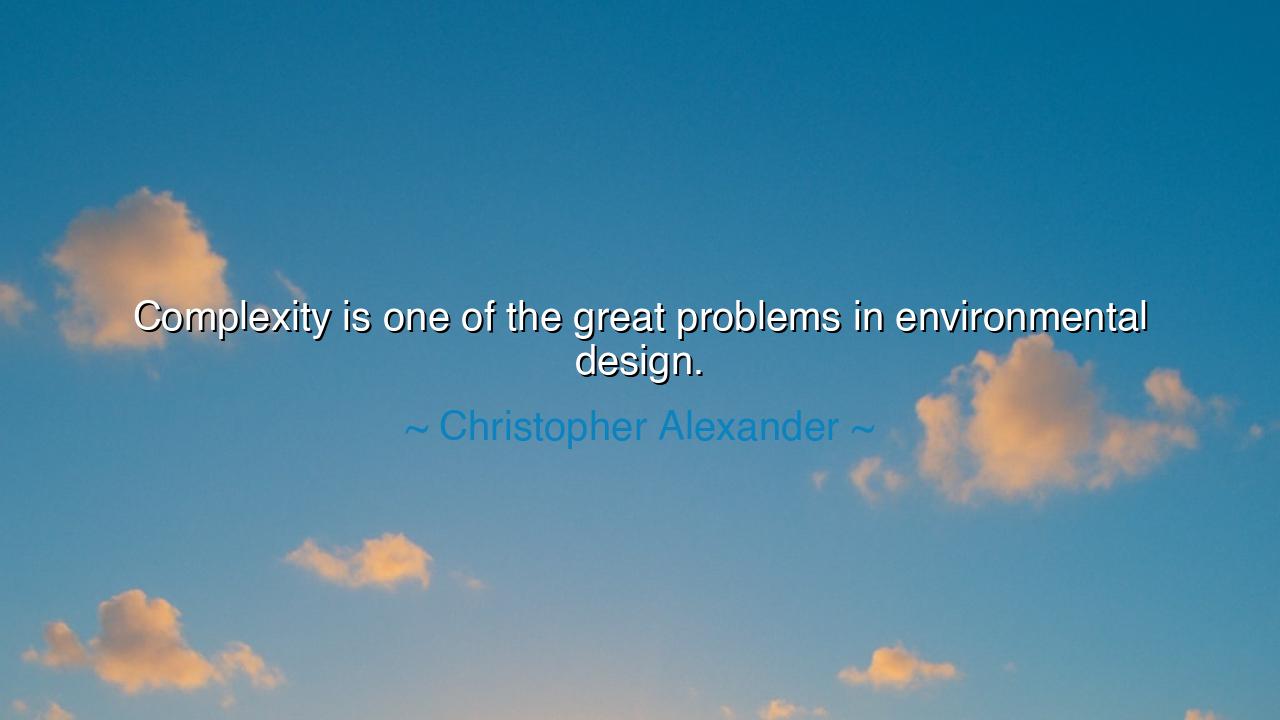
Complexity is one of the great problems in environmental design.






“Complexity is one of the great problems in environmental design.” Thus spoke Christopher Alexander, the philosopher-architect, the craftsman of harmony and life within space. In this statement — spare yet profound — he revealed a truth that extends beyond architecture into the very fabric of existence: that when human creation grows too complex, it loses its soul. For Alexander saw what many of his generation could not — that beauty and order arise not from complication, but from clarity, coherence, and a deep reverence for life’s natural patterns. His words are not the lament of a scholar, but the warning of a sage — that the overcomplication of our environments leads not to progress, but to alienation.
The origin of this quote lies in Alexander’s lifelong work as both a builder and thinker. In the mid-twentieth century, when cities were rising like machines and architecture had become a science of steel and glass, he sought to restore the forgotten language of human-centered design. In his seminal works — Notes on the Synthesis of Form and The Timeless Way of Building — he argued that modern architecture, obsessed with abstraction and efficiency, had become estranged from the rhythms of life. It was too complex, too fractured, too cold. He believed that good design should emerge organically, like a tree or a river, where every part grows naturally from the whole. But instead, architects and planners had constructed labyrinths of concrete, forms divorced from function, and cities that suffocated the spirit.
When Alexander speaks of complexity, he does not mean richness or depth — those are the qualities of living beauty — but the confusion born of disconnection. He means the tangled web of systems that do not speak to one another, of streets that serve no rhythm, of buildings that reject their context. He saw how modern design, instead of healing, often wounds. The more planners tried to control, the more they disrupted the subtle balance that makes a place feel alive. To him, a house, a garden, a city — these were not mere objects to be managed, but living organisms that needed simplicity with meaning, structure with soul.
Consider the example of Brasília, the planned capital of Brazil, built in the 1950s. It was conceived as the perfect modern city — symmetrical, efficient, geometrically pure. But when the people arrived, they found it strangely lifeless. The vast avenues discouraged walking; the distances crushed community. It was a city designed by reason, but not by heart. Brasília became a symbol of what Alexander warned against — a triumph of complexity over humanity, of form divorced from life. Compare this to an old Italian village, where each house seems to grow naturally from the slope of the land, where narrow paths twist yet feel intuitive, where the whole seems shaped by countless small acts of care rather than a single master plan. The latter breathes; the former suffocates.
Alexander’s insight reaches beyond architecture. It is a mirror for all of modern civilization. Complexity has become our idol, in systems, technologies, and societies alike. We build machines we cannot understand, economies that enslave rather than serve, institutions that drown in their own rules. The world, meant to sustain life, now bewilders it. We have mistaken intricacy for wisdom, confusion for progress. But the wisdom of the ancients — and of Alexander — teaches the opposite: that the greatest designs, like the greatest lives, are those that achieve unity and simplicity without losing depth.
In this sense, Alexander’s struggle is the struggle of every human being who seeks order amid chaos. He calls us to strip away what is unnecessary, to rediscover the essential patterns that connect us to nature, to one another, and to our own inner peace. Just as a well-built home shelters the soul, a well-ordered life shelters the heart. Simplicity does not mean poverty; it means clarity. It means to live and create with purpose, where every action and every form serves the whole.
So, my children, take this lesson into your own works and lives. When you build — whether a house, a community, or a dream — beware the lure of needless complexity. Ask instead, Does this give life? Does it bring harmony? Seek the pattern that fits the human hand, the human heart, the rhythm of the earth itself. For true design is not an act of control, but of listening.
And thus, remember Alexander’s wisdom: complexity without connection is chaos; simplicity with meaning is grace. To design the world — or to live within it — is to bring order from the living forces that already dwell within it. Strive always for that balance, where structure serves life, and where every stone, every gesture, and every choice becomes part of the great and timeless pattern of creation.






AAdministratorAdministrator
Welcome, honored guests. Please leave a comment, we will respond soon